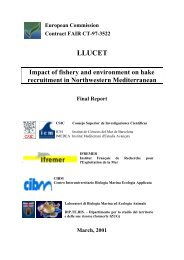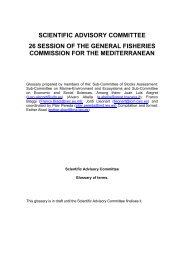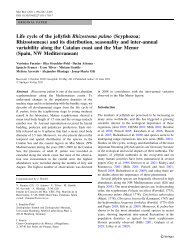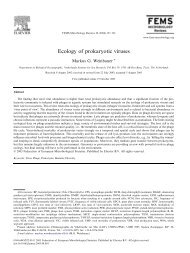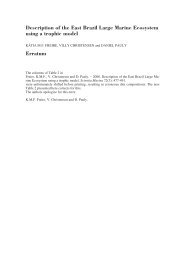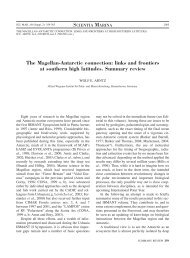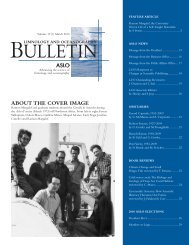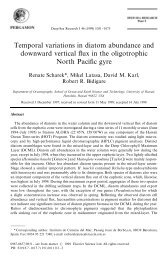REPORT OF THE WORKSHOP ON TRAWL SURVEY ... - FAO.org
REPORT OF THE WORKSHOP ON TRAWL SURVEY ... - FAO.org
REPORT OF THE WORKSHOP ON TRAWL SURVEY ... - FAO.org
Create successful ePaper yourself
Turn your PDF publications into a flip-book with our unique Google optimized e-Paper software.
• The use of robust parameters of general application in population dynamics such as the “Life<br />
Expectancy”, as an integral of the survival.<br />
• Application of a non-equilibrium surplus production model assessment using<br />
MEDITS data (by Tserpes G., Haralabous J. and Maravelias C.)<br />
Abstract: Biomass and MSY estimates for the hake stocks in the Greek seas were obtained from a non-equilibrium<br />
surplus model approach utilizing CPUE time series derived from the MEDITS surveys and fishery production data.<br />
The model was developed in the freely available R-language and the results demonstrated the existence of fisheries<br />
over-exploitation.<br />
• Permanent control of the state of trawl fisheries started in 1997 (By Djurovic M.)<br />
Abstract: Estimated population dynamics parameters of important species: Pandora, Pagellus erythrinus, Red<br />
Mullet, Mullus barbatus, Hake, Merluccius merluccius, Pink shrimp, Parapaeneus longirostris. Estimated total<br />
biomass of economical important demersal resources on the shelf area (hake, red mullet, red pandora, squid,<br />
octopus, pink shrimp) was about 2 700 tons.. Estimated MSY of demersal resources was 600 tons per year.<br />
Estimated average catch per unit effort (CPUE) of demersal resources last four years was about 19.47 kg/h. In<br />
October 2004 and February 2007 in frame of <strong>FAO</strong> Adriamed Project has been performed AdriMed trawl survey<br />
(MEDITS protocol) in Montenegrin territorial and adjacent waters. In 1997 CPUE has fallen to 20 kg/h and for the<br />
last few years this value did not change. This indicates that some kind of the state of equilibrium was reached<br />
between fishing effort and resources.<br />
Conclusions from the Session 2<br />
14. The main conclusions from the discussion following the presentations are summarized<br />
below:<br />
• It has been noted that analyses of time series data trends derived from surveys, other<br />
than of MEDITS, are also performed.<br />
• Since the first MEDITS surveys covered only those species listed in the primary and<br />
secondary list of the sampling manual, it has been pointed out that the consistency of<br />
data should be checked when analyzing spatio-temporal variations for those species<br />
not included in any of the above-mentioned MEDITS lists.<br />
• Assessment studies should be supported besides the MEDITS data with all the data<br />
available such as the fishing effort or commercial catch data.<br />
• The use of trawl surveys data in tuning the application of analytical models for stock<br />
assessment was stressed.<br />
• It was noted that in the Mediterranean region the data for defining nursery areas of<br />
hake already exist and this should be taken into account for recommending closed<br />
areas when needed.<br />
• The experience achieved in the ICES region by the trawl surveys should encourage<br />
Mediterranean scientists to engage in common activities on assessment studies.<br />
SESSI<strong>ON</strong> 3. APPLICATI<strong>ON</strong> TEST FOR SURPLUS PRODUCTI<strong>ON</strong> MODELS<br />
15. The aim of this session was to test an application of surplus production models with the<br />
data brought by the participants. The application was made during the meeting with a tool at<br />
the participants’ disposal. The methods and the information to be brought by the participants<br />
are described in a document made available on the GFCM website before the workshop. Mr<br />
Alvaro Abella was the moderator for this application test.<br />
9




